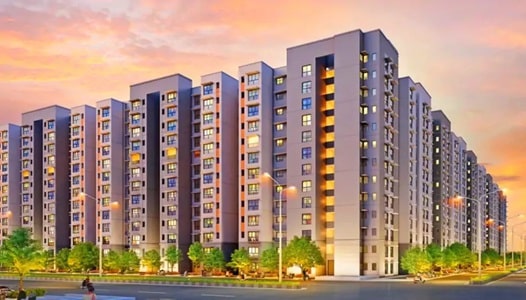The global commercial real estate market is a multi-trillion dollar industry that is constantly evolving. Major centres such as New York, London, and Hong Kong have historically dominated the market, drawing in investors looking for long-term value and steady returns. But change is in the atmosphere, and India is quickly becoming a major player in this scene.
With its booming economy, rising population, and rapid urbanization, India is rapidly emerging as a major player in the global commercial real estate market.
India’s commercial real estate market has shown steady growth, defying the global trend that has been struggling in recent years. India’s economy is currently the fifth largest in the world, but by 2029 it is expected to rise to the third rank.
The Shifting Landscape of Global Real Estate
The commercial real estate market has undergone significant changes in recent times on a global scale. This dynamic landscape has been influenced by changing economic trends, changing demographics, and technological advancements. What we’ve seen is:
- The Rise of Technology-driven industries: With businesses like Google, Amazon, and Facebook growing their global operations, the tech sector is booming. Due to this, there is a growing need for contemporary office buildings and data centres, especially in places with a large concentration of tech talent.
- The Changing Demographics: The workforce is evolving due to the preferences of Gen Z and Millennials, who are about to enter their prime working years. These generations value adaptability, teamwork, and sustainability above all else, which has led to the growth of co-working spaces and environmentally friendly structures.
- The Emergence of New Economic Powers: While established economies like the US and Europe remain strong, countries like India and China are experiencing rapid economic growth. This is creating new investment opportunities in these emerging markets.
India’s Rise: Current Market Scenario
India’s commercial real estate (CRE) market is currently valued at USD 33.62 billion and is expected to grow to USD 87.57 billion. From 2023 to 2028, the growth is expected to continue at an impressive CAGR of 21.1%.
Source: Mordor Intelligence
The data, however, speaks for itself: CRE is an attractive investment choice that offers distinct benefits and long-term prosperity. New market opportunities are opening up as it keeps expanding.
What’s also catching investors’ attention is the combination of impressive returns, reliability, and the diversification it brings to their portfolios. Notably, the most sought-after investment options are office spaces, retail spaces, and flexible spaces.
Report Summary:
| Market Size (2023) | USD 67.08 billion |
| Market Size (2028) | USD 223.25 billion |
| CAGR (2023-2028) | 27.19% |
| Study Period | 2018-2028 |
| Forecast Units | Value (USD billion) |
| Key Market Drivers | Mounting government initiatives and urban development policies and programs.
Growing demand for flexible and co-working spaces. |
Market Drivers and Growing Potential
According to Ernst & Young, over 50% of the $4 billion in private credit that entered India in the first half of 2023 went towards commercial real estate. In contrast, $5.3 billion was spent in 2022 overall. According to a firm survey of fund managers, the number of real estate deals is expected to rise over the next 18 months.
Strategic Destination
India’s strong domestic demand, coupled with its established status as a global hub for technology and research and development, strong start-up culture, and affordable, high-quality real estate are all contributing to the country’s commercial sector growth.
In the last three years, the data centre industry has doubled in size to 722 MW, with a strong 91% occupancy rate. Over the next three years, this market is expected to double in size, requiring an additional investment of approximately USD 5 billion by itself.
- Economic Powerhouse: India is now the world’s fifth-largest economy, projected to become the third-largest by 2029. This robust economic growth fuels demand for office spaces, retail complexes, and warehousing facilities.
Talent Pool
The 1.3 billion people who make up India’s population are largely under 30, making them both skilled labour and potential customers. Their demands have also redefined the fundamentals of consumption, providing plenty of room for the coexistence of e-commerce and traditional brick-and-mortar retail. Retail shopping destinations are reinventing themselves and curating the shopper experience through a strong tenant management strategy, even as e-commerce continues to gain market share.
- Large Young Workforce: With a vast pool of young talent, India boasts a competitive advantage in the global knowledge economy. This attracts multinational companies seeking to establish their operations in the country, driving demand for high-quality office spaces.
Government Initiatives
The government has placed a strong emphasis on improving India’s investment climate, infrastructure, and other factors that are driving up demand for commercial real estate.
- Favorable Government Policies: Initiatives like REITs (Real Estate Investment Trusts) and RERA (Real Estate Regulation and Development Act) have increased transparency and investor confidence in the market. The government is also actively promoting infrastructure development, further enhancing real estate potential.
Prospects of Commercial Real Estate in Tier 2 & 3 Cities
The outlook for commercial real estate in Tier 2 and Tier 3 cities is bright and changing rapidly. Numerous factors influence how these cities’ commercial infrastructure is developing. The development of infrastructure, such as new highways, rail networks, and metro systems that provide better connectivity, is essential. Commercial development in Tier 2 and Tier 3 cities has increased as a result of the increase in the cost of commercial real estate in metro areas. The growth has also been aided by the demand for reasonably priced spaces and the trend towards entrepreneurship.
- Emerging Tier 2 and Tier 3 Cities: Previously overlooked cities are now experiencing rapid economic and infrastructural growth. This presents exciting investment opportunities in these emerging markets.
Overall, Tier 2 and Tier 3 cities present significant prospects for the development of commercial real estate and have grown in popularity among investors.
Challenges
Despite its undeniable potential, India’s commercial real estate market still faces some challenges that need to be addressed. These include:
Infrastructure bottlenecks: Despite the fact that a lot of infrastructure is being developed, some places still lack sufficient transport networks and connectivity, which lowers the value of real estate in those areas.
Regulatory complexity: For foreign investors, navigating the regulatory landscape can be difficult.
Market transparency: Although things have become more transparent, issues with data accessibility and market research still exist.
However, these challenges also present opportunities for investors willing to undertake thorough due diligence and adopt a strategic approach.
Investment Opportunities and Strategies
The commercial real estate (CRE) industry in India is seeing tremendous growth. The market is reaching new heights in terms of demand for premium office spaces, shopping malls, prime high street locations, and SCO (Shop-Cum-Office) plots.
India’s commercial real estate market has been experiencing steady growth and presents several new opportunities.
Emerging Trends
- High-quality office spaces: The demand for modern office space in major cities and tech hubs is expected to remain strong.
The commercial real estate market in India is being driven by innovative office space ideas that cater to the evolving needs of businesses. Businesses are seeking collaborative, adaptable workspaces that enhance employee happiness and productivity.
By the end of 2023, over sixty million square feet of office space in both metro and non-metro areas are expected to be occupied, according to a report released by Colliers and Qdesq.
- Coworking Spaces: The flexible work environment provided by co-working spaces is becoming increasingly popular, especially among startups and freelancers.
Coworking spaces have grown remarkably quickly since they were first established. The Indian market for flexible space was estimated to be worth 47 million square feet as of H1 2022, and by the end of 2025, it is expected to have grown to over 80 million square feet.
We anticipate that coworking spaces will have a significant impact on the commercial real estate market in 2023, bringing with them new opportunities for major players in the market.
Also See: Factors Influencing Plot Loan Interest Rates
A New way to own luxury assets: The Fractional Ownership Model
In India, fractional ownership of real estate is quickly becoming a viable investment option for investors, especially high net worth individuals (HNIs), and even end users, who may be able to generate consistent returns of 8–10% from the prospering real estate market.
Investing in CRE can be made more affordable for investors via fractional ownership. Consider it as purchasing a portion of a bigger asset, such as a portion of an office or retail complex.
The Indian fractional ownership market is expected to grow from Rs 1,500 crore in 2019 to Rs 4,000 crore in 2023, according to a report by TruBoard Partners.
Real Estate Investment Trusts (REITs)
The introduction of Real Estate Investment Trusts (REITs) in India has opened up new avenues for investment in the commercial real estate sector. REITs provide easier access to real estate investments, attracting global capital.
Real estate investments are usually high-ticket investments that require greater capital. They are a good alternative to these high-ticket investments while diversifying your investment portfolio. REITs generate income through rents. As a result, investors can profit regularly from their investments.
With SEBIs recent regulations, the minimum investment has considerably reduced to INR 15,000. Also, the lot size has been reduced to one unit. Hence, investors who can afford to invest this amount can go ahead and invest.
Foreign Direct Investment (FDI):
India has been attracting significant foreign direct investment in the real estate sector. Foreign investors can now more easily participate in the Indian commercial real estate market thanks to the liberalisation of FDI policies.
Increased participation from foreign players has been made possible by the liberalisation of FDI policies and the creation of Real Estate Investment Trusts (REITs), which have injected capital into commercial projects and raised investor confidence.
Comparative Analysis with Other Global Real Estate Hubs:
Compared to other global hubs like USA, China, and Europe, India offers:
Returns on Investment
One of the main attractions for investors in Indian commercial real estate is the high potential for returns. Commercial property rentals in major Indian cities offer annual yields as high as 7-10%, compared to mature markets like the US, China, and Europe, where such yields range from 2% to 4.5%. This substantial potential for gain is a significant drawcard for investors eyeing Indian commercial properties.
Growth Potential
India is one of the fastest-growing economies globally. Urbanization, demographic changes, increasing disposable income, and pro-industry policies are contributing to a booming commercial real estate sector. In contrast, markets like China, and Europe, and even the U.S. have matured, with less space for further growth. The room for expansion in the Indian market offers exciting prospects for investors seeking new growth avenues.
Thus, India is fast-emerging as a prime choice for global commercial real estate investors due to:
- Lower entry costs and higher potential returns.
- A large talent pool and a growing consumer base.
- Government initiatives and supportive policies.
Bottom Line
India’s commercial real estate market offers investors enormous potential despite some challenges. India is well-positioned to emerge as a major global hub for commercial real estate investment due to its sound economic foundation, young workforce, and supportive government policies and is fast-emerging as a prime choice for global commercial real estate investors.
India’s commercial real estate in 2023 is brimming with transformative opportunities. As we move into this bright future, let’s take advantage of every chance, capitalise on these new trends, and steer our companies in the direction of expansion, sustainability, and unmatched success.
Assetmonk is a dedicated alternative investment platform that provides investors with exceptional alternative investment choices backed by real estate. These investment products include asset-backed security and an easy exit strategy in addition to an impressive 17% IRR guarantee to our valued investors. These investment opportunities, which have been carefully selected from India’s burgeoning private markets, are supervised by a trustee who is registered with SEBI. With a minimum investment of just 10 lakhs, you can enjoy the benefits of stress-free investing and rewardingly high returns.
FAQs
Q1. What are the regulatory requirements for foreign investors?
A: Foreign investors need to comply with various regulations, including:
- Foreign Direct Investment (FDI) regulations.
- Real Estate Regulatory Authority (RERA) guidelines.
- Tax regulations.
It is recommended to seek professional advice to understand the specific regulatory requirements applicable to foreign investors.
Q2. Is India really a rising star in the commercial real estate market?
A: Yes, India is rapidly emerging as a major player in the global commercial real estate market. With its strong economic growth, young and talented workforce, and supportive government policies, India offers significant potential for investors.
Q3. How to invest 10 lakhs for monthly income?
- The best way to invest Rs 10 lakhs for monthly income is structured debt real estate. Structured debt backed by real estate refers to investment products that offer fixed-income opportunities by utilizing real estate assets as collateral. Real estate-backed investments can offer attractive returns through interest payments and potential capital appreciation. Generally, these investments have the potential to yield returns ranging from 12 percent to 18 percent.


















